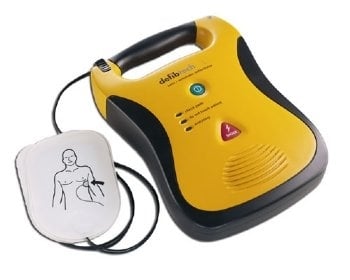According to the American Heart Association, sudden cardiac arrest (“SCA”) is a leading cause of death in the United States. It is estimated that more than 350,000 lives are taken each year due to the abrupt loss of heart function. However, with technological advances, the number of deaths due to SCA have been lowered through the use of an automated external defibrillator (“AED”). An AED is a portable medical instrument that delivers an electrical impulse to the heart to disrupt and correct an otherwise fatal irregular heartbeat (arrhythmia) and allows a normal rhythm to resume. Although AEDs have been credited with saving countless lives by making it possible for non-medical individuals to respond to a medical emergency, the question must be asked: “Is the liability worth the risk?”
 The purchase and availability of AEDs is controlled by state and federal laws and regulations. Pursuant to Florida law, AEDs are required to be installed in public schools, dental offices, and assisted living facilities. AEDs are optional in state parks and state owned or leased facilities. There is no requirement that community associations in Florida install AED devices on association property and/or association fitness facilities. Although not legally required, there is a growing trend of community associations considering installing AEDs on association property to better protect their residents. When considering whether or not to install an AED device, associations must ensure that all parties (i.e., association management, board of directors, residents, and any other authorized user) understand the potential liability associated with the use of an AED and the protections afforded to them under Florida law.
The purchase and availability of AEDs is controlled by state and federal laws and regulations. Pursuant to Florida law, AEDs are required to be installed in public schools, dental offices, and assisted living facilities. AEDs are optional in state parks and state owned or leased facilities. There is no requirement that community associations in Florida install AED devices on association property and/or association fitness facilities. Although not legally required, there is a growing trend of community associations considering installing AEDs on association property to better protect their residents. When considering whether or not to install an AED device, associations must ensure that all parties (i.e., association management, board of directors, residents, and any other authorized user) understand the potential liability associated with the use of an AED and the protections afforded to them under Florida law.
“The Cardiac Arrest Survival Act” (“Cardiac Act”) codified in section 768.1325 of the Florida Statutes was enacted by the Legislature in order to encourage consumer purchase, placement, and use of AEDs. The Cardiac Act only applies to situations in which an AED is used to resuscitate an individual. In situations not involving an AED, the “Good Samaritan Act” codified in section 768.13 of the Florida Statutes applies. The Good Samaritan Act provides that:
“Any person, including those licensed to practice medicine, who gratuitously and in good faith renders emergency care or treatment…at the scene of an emergency outside of a hospital, doctor’s office, or other place having proper medical equipment, without objection of the injured victim[s], shall not be held liable for any civil damages… where the person acts as an ordinary reasonably prudent person would have acted under the same or similar circumstances.”
The Cardiac Act shields the AED’s owner and its operator who used it in an effort to render aide from liability in the event of a perceived medical emergency. A perceived medical emergency occurs when a reasonable person believes that an individual is experiencing a life-threatening medical condition involving the heart that requires an immediate medical response. Pursuant to the Cardiac Act, the user of an AED is immune from liability for any resulting harm from the use or attempted use on the victim if:
1. There is a perceived medical emergency; and
2. No objection is made by the victim against the use of the device on their person.
The Cardiac Act further extends immunity to community associations organized under Chapters 617, 718, 719, 720, 721, and 723 of the Florida Statutes. However, the shield of immunity afforded to community associations can be pierced if the harm caused to the victim was due to the failure of the association to properly maintain and test the AED device. Additionally, immunity will not be granted to the association if the harm was due to the association’s failure to provide appropriate training to the employee or agent of the association when the employee or agent was the person who actually used the device on the victim. However, training by the association will not be required if any of the following is met:
1. The AED device is equipped with audible, visual, or written instructions on its use, including any such visual or written instructions posted on or adjacent to the device; OR
2. The employee or agent was not an employee or agent who would have been reasonably expected to use the device; OR
3. The period of time elapsing between the engagement of the person as an employee or agent and the occurrence of the harm, or between the acquisition of the device and the occurrence of the harm in any case in which the device was acquired after engagement of the employee or agent, was not a reasonably sufficient period in which to provide the training.
Even though training may not be required for one of the reasons set forth above, common sense dictates that any key personnel, such as the staff in charge of athletic activities and the manager, should be trained in the use of the AED device. In regard to where the AED should be installed, the Cardiac Act does not provide guidance. Again, common sense dictates it should be in a visible area. Also, an insurer cannot exclude damages resulting from the use of an AED from coverage under a general liability policy issued to the community association.
In relation to immunity extended to “the person,” the Cardiac Act further provides that the user will not be immune from liability if:
1. The harm was caused by user’s willful or criminal misconduct, gross negligence, reckless disregard or misconduct, or a conscious, flagrant indifference to the rights or safety of the victim who was harmed; OR
2. The person who used the AED on the victim is a licensed or certified health professional who used the AED device while acting within the scope of the license or certification of the professional and within the scope of the employment or agency of the professional; OR
3. The person is a hospital, clinic, or other entity whose primary purpose is providing health care directly to patients, and the harm was caused by an employee or agent of the entity who used the device while acting within the scope of the employment or agency of the employee or agent; OR
4. The person is an acquirer of the device who leased the device to a health care entity, or who otherwise provided the device to such entity for compensation without selling the device to the entity, and the harm was caused by an employee or agent of the entity who used the device while acting within the scope of the employment or agency of the employee or agent; OR
5. The person is the manufacturer of the device.
If an association decides to proceed with placement of an AED device on association property, then the board should adopt rules and regulations in the association’s governing documents which address the following: (1) the location of the AED device, (2) notification procedure should the AED be removed from its designated location to a secondary location on a temporary basis, (3) maintenance and testing of the AED, (4) authorized users, (5) training for the authorized users, (6) written instructions posted next to the device that provide a “how to” in case a trained user is not available, and (7) regular notice to the owners as to the AED device’s availability, location, and identification of trained staff and owners.
Any association that provides athletic activities for its members should seriously consider owning an AED device. Should you have any further questions about whether or not the liability is worth the risk, then contact your association’s attorney as to whether an AED is right for your association. Save a life by having an AED device available at your association!
Jeffrey Rembaum, Esq. of Kaye, Bender, Rembaum attorneys at law, legal practice consists of representation of condominium, homeowner, commercial and mobile home park associations, as well as exclusive country club communities and the developers who build them. He is a regular columnist for The Condo News, a biweekly publication and was inducted into the 2012, 2013 & 2014 Florida Super Lawyers. He can be reached at 561-241-4462.

